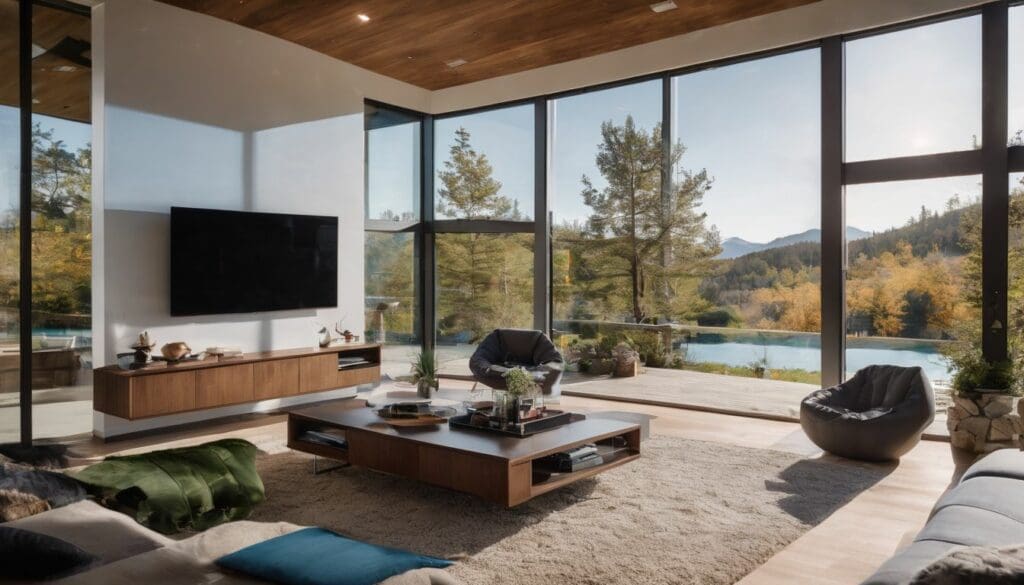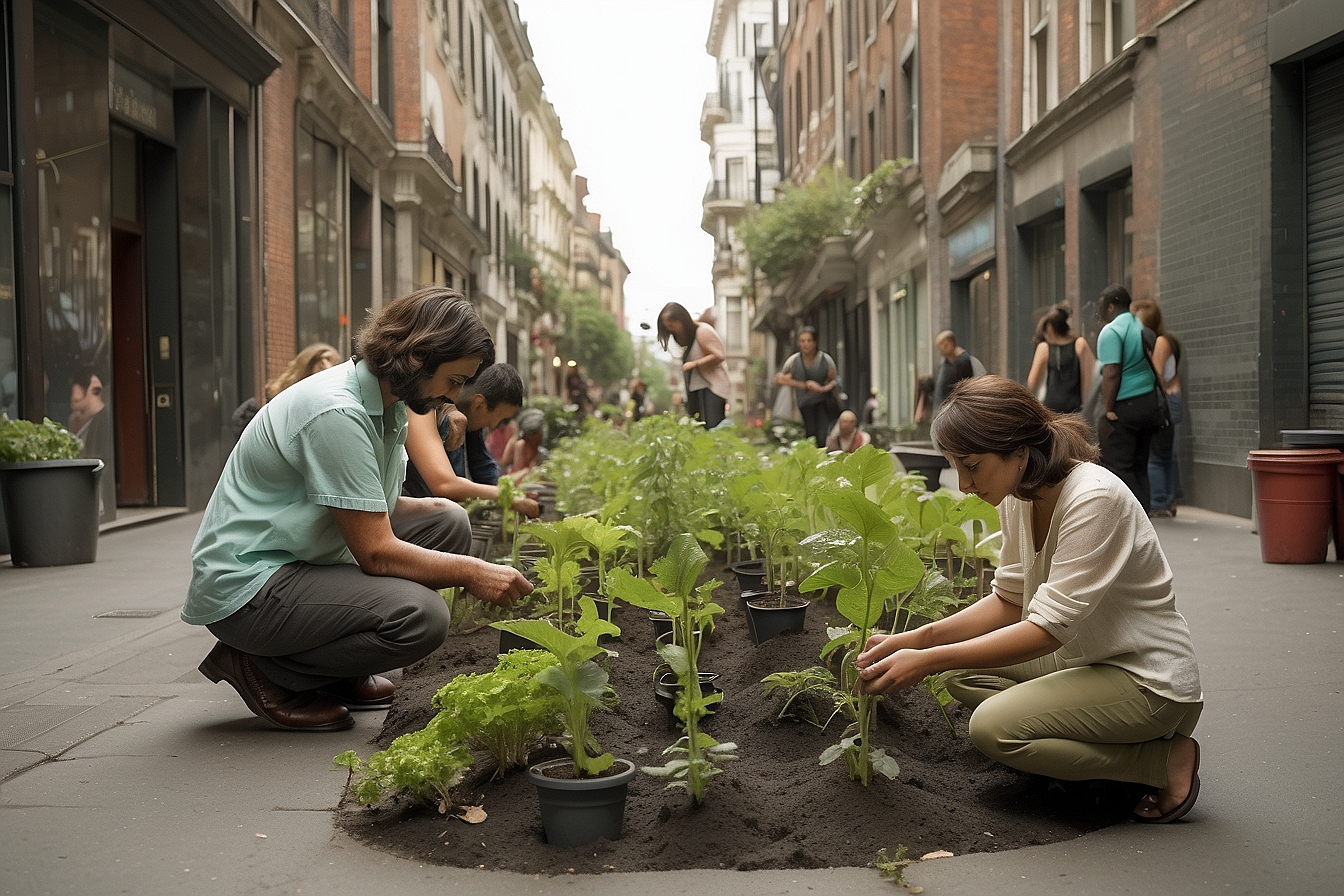We all know the pinch when our energy bills land on the doormat, a shared sigh of frustration in homes far and wide. Like you, it’s not only our bank balances feeling the squeeze; research indicates household appliances munch through as much as 30% of the average home’s energy consumption.
In light of this, we’ve rolled up our sleeves and dived into the world of energy-efficient gadgets, arming ourselves with eco-friendly solutions that are knocking on your door. Embark on a journey with us to uncover how savvy choices can champion both environmental stewardship and financial wellbeing – because caring for our planet shouldn’t cost the earth.
Key Takeaways
- Energy – efficient appliances reduce your home’s energy consumption and can save you money on utility bills.
- Choosing sustainable materials and designing for energy efficiency are essential when building a self-built green home.
- Incorporating renewable energy sources like solar panels or wind turbines decreases reliance on nonrenewable fuels, lowering your carbon footprint.
- Smart home technology enhances the sustainability of homes by allowing efficient management and control over energy usage.
- Sustainable landscaping, water efficiency, and waste reduction practices complement the use of low-energy appliances in creating an eco-friendly home environment.
The Importance of Energy-Efficient Appliances for Green Homes
Energy efficiency is crucial for green homes, as it helps to reduce energy consumption and lower utility bills. Traditional appliances can have a significant environmental impact, making the use of eco-friendly and sustainable appliances essential for conservation.
Understanding energy efficiency
We tackle energy efficiency by choosing appliances and systems that do more with less. It’s the smart use of technology to cut down on electricity or gas without sacrificing quality or performance.
We opt for low-energy lighting fixtures, invest in energy-efficient refrigerators, and support brands that prioritise sustainability in their designs.
Our commitment extends beyond just buying products with an Energy Star label; we dig deeper into each appliance’s features. By selecting eco-conscious home heating systems and energy-saving dishwashers, we’re actively reducing our carbon footprint.
This conscious approach drives us when exploring the environmental impact of traditional appliances next.
Environmental impact of traditional appliances
Traditional appliances have a significant environmental impact, contributing to high energy consumption and greenhouse gas emissions. These appliances often consume more electricity or water than necessary, leading to increased resource depletion and pollution.
Additionally, the production and disposal of traditional appliances can result in harmful chemicals being released into the environment, further exacerbating their negative impact.
Furthermore, these appliances may have a shorter lifespan, leading to more frequent replacements that contribute to electronic waste accumulation.
Moving towards low-energy and eco-friendly appliances is crucial for reducing the environmental footprint of household activities. By making this shift, we can greatly minimise energy usage and reduce our carbon footprint.
Benefits of energy-efficient appliances
Energy-efficient appliances offer significant benefits for environmentally conscious individuals. They consume less energy, helping to reduce carbon emissions and decrease the environmental impact of daily activities.
Additionally, these appliances can lead to lower utility bills due to their reduced energy consumption. Moreover, they often have a longer lifespan than traditional counterparts, reducing the need for frequent replacement and contributing to sustainable living practices.
Transitioning to energy-efficient appliances is a crucial step in creating green homes and supporting conservation efforts. By choosing eco-friendly alternatives such as low-energy lighting fixtures and sustainable cooking appliances, individuals can actively contribute to environmental preservation while enjoying cost savings and long-term sustainability.
How to Find Eco-Friendly and Sustainable Appliances
When looking for eco-friendly and sustainable appliances, consider brands like Miele, SMEG, and Dualit that prioritise energy efficiency. Look for alternatives to plastic and electricity-heavy appliances to reduce emissions and save on electricity bills.
Brands to consider (Miele, SMEG, Dualit, etc.)
When choosing low-energy appliances for green homes, environmentally conscious individuals should consider the following reputable brands:
- Miele: Known for their energy-efficient refrigerators, eco-friendly air conditioning units, and sustainable home cooling solutions.
- SMEG: Offers a range of energy-saving dishwashers, green washing machines, and environmentally friendly home electronics.
- Dualit: Provides low-energy lighting fixtures, eco-conscious home heating systems, and energy-efficient water heaters.
Alternatives to plastic and electricity-heavy appliances
Opting for stainless steel or glass kitchenware can reduce the use of plastic in the kitchen. Ensuring that appliances such as kettles and toasters have an energy-saving feature will help lower electricity consumption. Choosing bamboo or wooden utensils over plastic ones helps to reduce dependency on plastic materials. Replacing traditional incandescent light bulbs with LED or CFL lighting fixtures significantly cuts down on electricity usage. Selecting energy-efficient appliances such as air conditioners and refrigerators can lead to a substantial reduction in overall energy consumption. Upgrading to an eco-friendly washing machine that uses less water and electricity is a practical choice for sustainable living.
Importance of reducing emissions and electricity bills
Reducing emissions and electricity bills is crucial for sustainable living. By opting for energy-efficient appliances, we can significantly lower our carbon footprint and contribute to a greener environment.
In addition, using low-energy appliances helps in reducing utility bills, allowing us to save money while advancing our eco-conscious lifestyle.
Investing in low-energy appliances not only benefits the environment but also our financial well-being. Choosing energy-efficient water heaters, eco-friendly air conditioning units, and sustainable home heating systems supports green living while lowering electricity expenses — a win-win situation for both your pocket and the planet.
Energy-Efficient Appliances: A Cornerstone of Green Homes
Energy-efficient appliances are essential for reducing energy consumption, cutting utility bills, and ensuring a longer lifespan for your household equipment. Read on to discover how these low-energy appliances can make a significant impact on your green home.
Reduced energy consumption
Energy-efficient appliances drastically reduce energy consumption, helping to conserve natural resources and lower electricity bills. Upgrading to low-energy lighting fixtures, an energy-saving dishwasher, and an eco-friendly air conditioning unit can significantly decrease overall power usage in a green home.
By investing in environmentally friendly home electronics and eco-conscious heating systems, individuals can actively contribute to sustainable living while reducing their environmental impact.
Green living appliances are designed with the aim of minimising electricity usage. Eco-friendly water heaters and energy-efficient refrigerators are important components for those looking to build an environmentally conscious household.
Lower utility bills
Energy-efficient appliances lead to lower utility bills, reducing your overall energy costs throughout the year. These appliances consume less energy, translating to significant savings on electricity and gas bills.
Investing in eco-friendly and low-energy appliances is a practical step in creating an environmentally friendly home while positively impacting your finances.
With energy-efficient refrigerators, air conditioning units, dishwashers, lighting fixtures, water heaters, and home heating systems, you can significantly cut down on monthly utility expenses.
Longer lifespan
Energy-efficient appliances have a longer lifespan than traditional ones. This means that they require replacement less frequently, reducing environmental impact and saving money in the long run.
By investing in eco-friendly appliances such as energy-efficient refrigerators, dishwashers, air conditioning units, and water heaters, you can contribute to conservation efforts while enjoying durable and reliable home essentials.
Choosing low-energy appliances is a crucial step towards sustainable living. When seeking out green energy appliances for your home, consider their longevity alongside their energy-saving capabilities.
Building a Self-Built Green Home
When building a self-built green home, it’s important to carefully select the site to maximise energy efficiency and sustainability. Using sustainable building materials and designing for energy efficiency are also crucial aspects of creating a green home.
Site selection
When choosing a location for your self-built green home, consider factors such as solar orientation, prevailing winds, and access to public transportation. Opting for a site with good sun exposure will allow you to maximise the use of renewable energy sources like solar panels.
Additionally, selecting a location that encourages natural ventilation can help reduce the need for air conditioning. Prioritise sites within close proximity to public transport options or amenities to minimise reliance on personal vehicles and decrease your carbon footprint.
Once you’ve determined the ideal site for your green home, it’s essential to focus on sustainable building materials and energy-efficient design practices that align with your eco-conscious values.
Sustainable building materials
When considering sustainable building materials for our green homes, it’s crucial to prioritise environmentally friendly options such as recycled steel, reclaimed wood, and bamboo.
These materials not only reduce the carbon footprint of construction but also promote responsible land use. Additionally, incorporating low-impact materials like straw bales and rammed earth can enhance the energy efficiency of our green homes while minimising environmental impact.
Furthermore, utilising eco-conscious insulation materials such as natural wool or cellulose can contribute to maintaining comfortable indoor temperatures without relying heavily on heating or cooling systems.
Energy-efficient design
When designing a green home, we prioritise energy efficiency in all aspects. This includes using sustainable building materials and implementing intelligent design features that reduce energy consumption.
By orienting the house to maximise natural light and airflow, incorporating proper insulation, and utilising energy-efficient windows and doors, we create a comfortable living space while minimising the need for heating and cooling appliances.
We also integrate renewable energy sources such as solar panels or wind turbines into the home’s design. These not only reduce reliance on traditional power grids but also contribute to a lower carbon footprint.
Renewable energy sources
Renewable energy sources are crucial for sustainable living. We can harness solar power through panels installed on rooftops, converting sunlight into electricity. Wind turbines also capture wind energy to generate power for homes and communities.
Additionally, hydroelectricity utilises the force of flowing water to produce sustainable energy. Embracing these renewable sources reduces dependency on nonrenewable fossil fuels while minimising our carbon footprint, contributing towards a greener and more environmentally friendly future.
Integrating renewable energy sources complements low-energy appliances, enabling homes to operate efficiently with minimal impact on the environment. By incorporating such eco-friendly methods, we actively participate in building a cleaner and more sustainable world for future generations.
Sustainable Living Beyond Energy-Efficient Appliances
We also explore sustainable living beyond energy-efficient appliances, covering water efficiency, smart home technology, sustainable landscaping, and waste reduction. Click here to learn more about creating an eco-friendly and sustainable home environment.
Water efficiency
Water efficiency is a vital component of sustainable living. By incorporating water-efficient fixtures and appliances, such as low-flow faucets, showerheads, and toilets, we can significantly reduce water consumption in our homes.
Additionally, capturing rainwater for landscaping and using greywater systems for non-potable uses further enhances our efforts towards conserving this precious resource.
Implementing smart irrigation systems with moisture sensors ensures that outdoor watering is only done when truly necessary, preventing water wastage in gardens and lawns. Furthermore, adopting eco-friendly practices like xeriscaping reduces the demand for irrigation altogether.
Smart home technology
Smart home technology allows us to control and manage our energy usage more efficiently. We can monitor and adjust lighting, heating, and cooling, utilising low-power appliances to reduce our environmental impact.
These systems help us save energy, lower utility bills, and contribute to a greener lifestyle while enjoying the convenience of modern living.
Implementing smart home technology goes beyond just reducing energy consumption; it also enhances the overall sustainability of our homes. By integrating eco-friendly appliances with smart technology, we can create an environment that promotes conservation and supports a green way of life for future generations.
Sustainable landscaping
To create a green home, consider sustainable landscaping. By using native plants and trees, we can reduce the need for excessive watering and chemical pesticides, which helps in preserving water resources and minimising chemical pollution.
Additionally, incorporating features such as rain gardens and permeable paving can help manage stormwater runoff effectively. These eco-conscious landscaping practices not only contribute to a healthier environment but also enhance the overall aesthetic appeal of your green home.
Incorporating sustainable landscaping plays a crucial role in reducing our environmental footprint. Instead of high-maintenance lawns, opting for drought-resistant plants helps conserve water while also providing habitats for local wildlife.
Waste reduction
After considering sustainable landscaping, waste reduction is another crucial aspect of creating an eco-friendly home. Implementing strategies for waste reduction, such as composting organic waste and reducing single-use plastics, can significantly minimise the environmental impact of household activities.
Utilising energy-efficient appliances and embracing sustainable living go hand in hand with minimising waste generation for a holistic green lifestyle.
Incorporating practices like recycling, upcycling, and repurposing materials also contributes to waste reduction while aligning with the ethos of environmentally conscious individuals striving for conservation and sustainability.
Conclusion
In conclusion, choosing low-energy appliances for green homes is a practical way to reduce environmental impact and save on utility bills. Energy-efficient appliances not only lower energy consumption but also contribute to sustainable living.
By opting for eco-friendly and energy-conscious appliances, we can all play a part in creating an environmentally conscious home and supporting conservation efforts. Making small changes in the home, such as using eco appliances, can make a big difference in the long run.
FAQs
1. What are low-energy appliances for green homes?
Low-energy appliances for green homes are environmentally friendly electronics designed to reduce energy consumption and support ecoconscious living.
2. Can installing an energy-efficient refrigerator make a difference in my home’s energy usage?
Yes, using an energy-efficient refrigerator helps cut down on electricity use and can significantly lower your home’s overall energy costs.
3. Why should I consider eco-friendly air conditioning units?
Eco-friendly air conditioning units consume less power while still keeping your home cool, making them a smart choice for both the environment and your electric bill.
4. Are there any benefits to using energysaving dishwashers?
Certainly! Energysaving dishwashers use less water and electricity, which is good for the planet and can save you money on utility bills.
5. How do I know if my lighting fixtures are lowenergy?
To find out if your lighting fixtures are lowenergy, look for labels that indicate they use LED or other energy-saving technology known to be more efficient than traditional bulbs.





